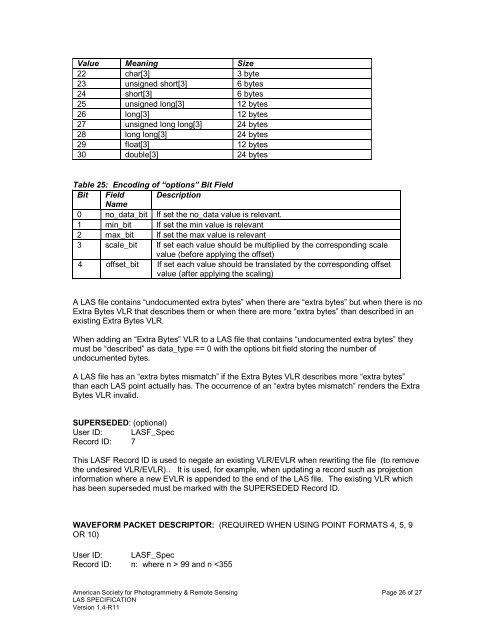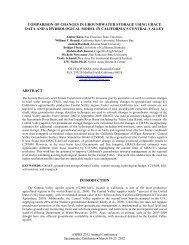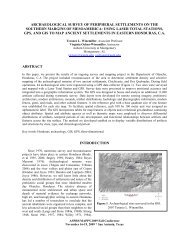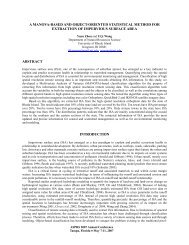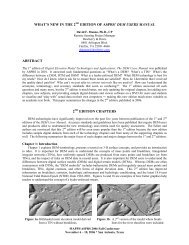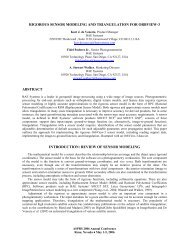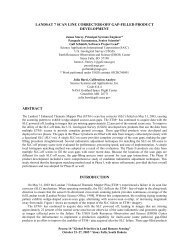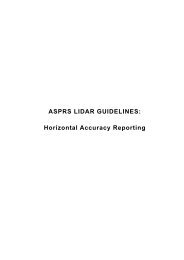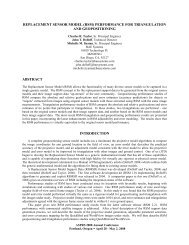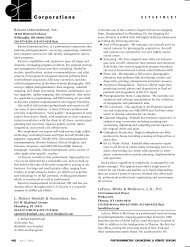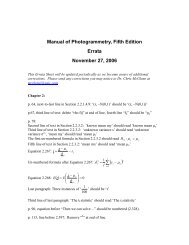LAS SPECIFICATION VERSION 1.4 – R11 - asprs
LAS SPECIFICATION VERSION 1.4 – R11 - asprs
LAS SPECIFICATION VERSION 1.4 – R11 - asprs
You also want an ePaper? Increase the reach of your titles
YUMPU automatically turns print PDFs into web optimized ePapers that Google loves.
Value Meaning Size<br />
22 char[3] 3 byte<br />
23 unsigned short[3] 6 bytes<br />
24 short[3] 6 bytes<br />
25 unsigned long[3] 12 bytes<br />
26 long[3] 12 bytes<br />
27 unsigned long long[3] 24 bytes<br />
28 long long[3] 24 bytes<br />
29 float[3] 12 bytes<br />
30 double[3] 24 bytes<br />
Table 25: Encoding of “options” Bit Field<br />
Bit Field<br />
Name<br />
Description<br />
0 no_data_bit If set the no_data value is relevant.<br />
1 min_bit If set the min value is relevant<br />
2 max_bit If set the max value is relevant<br />
3 scale_bit If set each value should be multiplied by the corresponding scale<br />
value (before applying the offset)<br />
4 offset_bit If set each value should be translated by the corresponding offset<br />
value (after applying the scaling)<br />
A <strong>LAS</strong> file contains “undocumented extra bytes” when there are “extra bytes” but when there is no<br />
Extra Bytes VLR that describes them or when there are more “extra bytes” than described in an<br />
existing Extra Bytes VLR.<br />
When adding an “Extra Bytes” VLR to a <strong>LAS</strong> file that contains “undocumented extra bytes” they<br />
must be “described” as data_type == 0 with the options bit field storing the number of<br />
undocumented bytes.<br />
A <strong>LAS</strong> file has an “extra bytes mismatch” if the Extra Bytes VLR describes more “extra bytes”<br />
than each <strong>LAS</strong> point actually has. The occurrence of an “extra bytes mismatch” renders the Extra<br />
Bytes VLR invalid.<br />
SUPERSEDED: (optional)<br />
User ID: <strong>LAS</strong>F_Spec<br />
Record ID: 7<br />
This <strong>LAS</strong>F Record ID is used to negate an existing VLR/EVLR when rewriting the file (to remove<br />
the undesired VLR/EVLR).. It is used, for example, when updating a record such as projection<br />
information where a new EVLR is appended to the end of the <strong>LAS</strong> file. The existing VLR which<br />
has been superseded must be marked with the SUPERSEDED Record ID.<br />
WAVEFORM PACKET DESCRIPTOR: (REQUIRED WHEN USING POINT FORMATS 4, 5, 9<br />
OR 10)<br />
User ID: <strong>LAS</strong>F_Spec<br />
Record ID: n: where n > 99 and n


